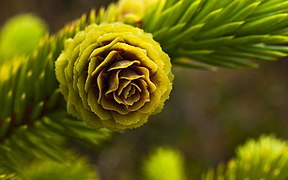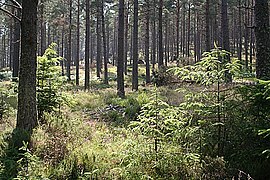Picea sitchensis
| Sitka spruce | |
|---|---|
 | |
| Sitka spruce in the Hoh Rainforest in Olympic National Park | |
Conservation status | |
 Least Concern (IUCN 3.1)[1] | |
Scientific classification | |
| Kingdom: | Plantae |
| Division: | Pinophyta |
| Class: | Pinopsida |
| Order: | Pinales |
| Family: | Pinaceae |
| Genus: | Picea |
| Species: | P. sitchensis |
Binomial name | |
Picea sitchensis (Bong.) Carr. | |
 | |
| Range highlighted in dark green | |
Picea sitchensis, the Sitka spruce, is a large, coniferous, evergreen tree growing to almost 100 m (330 ft) tall,[2] with a trunk diameter at breast height that can exceed 5 m (16 ft). It is by far the largest species of spruce and the fifth-largest conifer in the world (behind giant sequoia, coast redwood, kauri, and western redcedar);[3] and the third-tallest conifer species (after coast redwood and coast Douglas fir). The Sitka spruce is one of the few species documented to reach 91 m (299 ft) in height.[4] Its name is derived from the community of Sitka in southeast Alaska, where it is prevalent. Its range hugs the western coast of Canada and continues into northernmost California.
Contents
1 Description
1.1 Size
1.2 Age
1.3 Root system
1.4 Fire danger
2 Taxonomy
3 Distribution and habitat
4 Uses
5 Culture
6 Chemistry
7 Burls
8 Gallery
9 See also
10 References
11 External links
Description

Foliage, mature seed cone, and (center) old pollen cone
The bark is thin and scaly, flaking off in small, circular plates 5–20 cm (2.0–7.9 in) across. The crown is broad conic in young trees, becoming cylindric in older trees; old trees may not have branches lower than 30–40 m (98–131 ft). The shoots are very pale buff-brown, almost white, and glabrous (hairless), but with prominent pulvini. The leaves are stiff, sharp, and needle-like, 15–25 mm long, flattened in cross-section, dark glaucous blue-green above with two or three thin lines of stomata, and blue-white below with two dense bands of stomata.
The cones are pendulous, slender cylindrical, 6–10 cm (2.4–3.9 in) long [5] and 2 cm broad when closed, opening to 3 cm broad. They have thin, flexible scales 15–20 mm long; the bracts just above the scales are the longest of any spruce, occasionally just exserted and visible on the closed cones. They are green or reddish, maturing pale brown 5–7 months after pollination. The seeds are black, 3 mm long, with a slender, 7–9 mm long pale brown wing.
Size

Quinault Lake Spruce, the largest member of the species according to American Forest by points
More than a century of logging has left only a remnant of the spruce forest. The largest trees were cut long before careful measurements could be made. Trees over 90 m (300 ft) tall may still be seen in Pacific Rim National Park and Carmanah Walbran Provincial Park on Vancouver Island, British Columbia (the Carmanah Giant, at 96 m (315 ft) tall, is the tallest tree in Canada),[citation needed] and in Olympic National Park, Washington and Prairie Creek Redwoods State Park, California (United States); two at the last site are just over 96 m tall. The Queets Spruce is the largest in the world with a trunk volume of 337 m3 (11,900 cu ft), a height of 75.6 m (248 ft), and a 4.55 m (14.9 ft) dbh.[citation needed] It is located near the Queets River in Olympic National Park, about 26 km (16 mi) from the Pacific Ocean.
Age
Sitka spruce is a long-lived tree, with individuals over 700 years old known. Because it grows rapidly under favorable conditions, large size may not indicate exceptional age. The Queets Spruce has been estimated to be only 350 to 450 years old, but adds more than a cubic meter of wood each year.[6]
Root system
Living in an extremely wet climate, the Sitka spruce has a shallow root system with long lateral roots and few branchings.[7]
Fire danger
Despite the prevalence of Sitka spruce in cool, wet climates, its thin bark and shallow root system make it susceptible to fire damage.[7]
Taxonomy
DNA analysis[8][9] has shown that only Picea breweriana has a more basal position than Sitka spruce to the rest of the spruce. The other 33 species of spruce are more derived, which suggests that Picea originated in North America.[8]
Distribution and habitat

Sitka spruce forest in the Olympic Mountains, Washington
Sitka spruce is native to the west coast of North America, with its northwestern limit on Kenai Peninsula, Alaska, and its southeastern limit near Fort Bragg in northern California. It is closely associated with the temperate rain forests and is found within a few kilometers of the coast in the southern portion of its range. North of Oregon, its range extends inland along river floodplains, but nowhere does its range extend more than 80 km (50 mi) from the Pacific Ocean and its inlets. Sitka spruce also grows on the west coast of Norway, where it is considered an invasive species.
Uses
Sitka spruce is of major importance in forestry for timber and paper production. Outside its native range, it is particularly valued for its fast growth on poor soils and exposed sites where few other trees can prosper; in ideal conditions, young trees may grow 1.5 m (4.9 ft) per year. It is naturalized in some parts of Ireland and Great Britain, where it was introduced in 1831 by David Douglas,[10] and New Zealand, though not so extensively as to be considered invasive. Sitka spruce is also planted extensively in Denmark, Norway, and Iceland.[11][12] In Norway, Sitka spruce was introduced in the early 1900s. An estimated 50,000 hectares (120,000 acres) have been planted in Norway, mainly along the coast from Vest-Agder in the south to Troms in the north. It is more tolerant to wind and saline ocean air, and grows faster than the native Norway spruce.[13] But in Norway, the Sitka spruce is now considered an invasive species, and effort to get rid of it is being made.[14][15]

Felled Sitka spruce, Oregon Coast Range, 1918

End grain on P. sitchensis plank

Radially cut plank of P. sitchensis
Sitka spruce is used widely in piano, harp, violin, and guitar manufacture, as its high strength-to-weight ratio and regular, knot-free rings make it an excellent conductor of sound. For these reasons, the wood is also an important material for sailboat spars, and aircraft wing spars (including flying models). The Wright brothers' Flyer was built using Sitka spruce, as were many aircraft before World War II; during that war, aircraft such as the British Mosquito used it as a substitute for strategically important aluminium.
Newly grown tips of Sitka spruce branches are used to flavor spruce beer and are boiled to make syrup.[16][17]
The root bark of Sitka spruce trees is used in Native Alaskan basket-weaving designs.[18]
Culture

Kiidk'yaas in 1984
A unique specimen with golden foliage that used to grow on Haida Gwaii, known as Kiidk'yaas or "The Golden Spruce", is sacred to the Haida Native American people. It was illegally felled in 1997 by Grant Hadwin, although saplings grown from cuttings can now be found near its original site.
Chemistry
The stilbene glucosides astringin, isorhapontin, and piceid can be found in the bark of Picea sitchensis.[19][20]
Burls

Sitka spruce trees with burls, Olympic National Forest, Washington
In the Olympic National Forest in Washington, Sitka spruce trees near the ocean sometimes develop burls.
According to a guidebook entitled Olympic Peninsula, "Damage to the tip or the bud of a Sitka spruce causes the growth cells to divide more rapidly than normal to form this swelling or burl. Even though the burls may look menacing, they do not affect the overall tree growth."[21]
Gallery

Close-up of needles

New buds shedding bud scale

Green cone

Mature cones, Deepsyke forest, Peeblesshire, Scotland

Saplings growing in the understory of a Sitka spruce nursery, Portknockie, Scotland
See also
- List of superlative trees: The world´s tallest tree species
References
^ Farjon, A. (2013). "Picea sitchensis". The IUCN Red List of Threatened Species. IUCN. 2013: e.T42337A2973701. doi:10.2305/IUCN.UK.2013-1.RLTS.T42337A2973701.en. Retrieved 8 November 2017..mw-parser-output cite.citationfont-style:inherit.mw-parser-output .citation qquotes:"""""""'""'".mw-parser-output .citation .cs1-lock-free abackground:url("//upload.wikimedia.org/wikipedia/commons/thumb/6/65/Lock-green.svg/9px-Lock-green.svg.png")no-repeat;background-position:right .1em center.mw-parser-output .citation .cs1-lock-limited a,.mw-parser-output .citation .cs1-lock-registration abackground:url("//upload.wikimedia.org/wikipedia/commons/thumb/d/d6/Lock-gray-alt-2.svg/9px-Lock-gray-alt-2.svg.png")no-repeat;background-position:right .1em center.mw-parser-output .citation .cs1-lock-subscription abackground:url("//upload.wikimedia.org/wikipedia/commons/thumb/a/aa/Lock-red-alt-2.svg/9px-Lock-red-alt-2.svg.png")no-repeat;background-position:right .1em center.mw-parser-output .cs1-subscription,.mw-parser-output .cs1-registrationcolor:#555.mw-parser-output .cs1-subscription span,.mw-parser-output .cs1-registration spanborder-bottom:1px dotted;cursor:help.mw-parser-output .cs1-ws-icon abackground:url("//upload.wikimedia.org/wikipedia/commons/thumb/4/4c/Wikisource-logo.svg/12px-Wikisource-logo.svg.png")no-repeat;background-position:right .1em center.mw-parser-output code.cs1-codecolor:inherit;background:inherit;border:inherit;padding:inherit.mw-parser-output .cs1-hidden-errordisplay:none;font-size:100%.mw-parser-output .cs1-visible-errorfont-size:100%.mw-parser-output .cs1-maintdisplay:none;color:#33aa33;margin-left:0.3em.mw-parser-output .cs1-subscription,.mw-parser-output .cs1-registration,.mw-parser-output .cs1-formatfont-size:95%.mw-parser-output .cs1-kern-left,.mw-parser-output .cs1-kern-wl-leftpadding-left:0.2em.mw-parser-output .cs1-kern-right,.mw-parser-output .cs1-kern-wl-rightpadding-right:0.2em
^ Rushforth, Keith (1986) [1980]. Bäume [Pocket Guide to Trees] (in German) (2nd ed.). Bern: Hallwag AG. ISBN 3-444-70130-6.
^ "Agathis australis". Conifers. Retrieved April 9, 2012.
^ "Tallest Sitka Spruce". Landmark Trees. Retrieved April 9, 2012.
^ "Picea sitchensis". Oregon State University. Retrieved April 9, 2012.
^ (Van Pelt, 2001)
^ ab "Index of Species Information: Picea sitchensis". Fire Effects Information System. U.S. Forest Service. Retrieved July 3, 2015.
^ ab Ran, J.-H., Wei, X.-X. & Wang, X.-Q. 2006. Molecular phylogeny and biogeography of Picea (Pinaceae): Implications for phylogeographical studies using cytoplasmic haplotypes. Mol Phylogenet Evol. 41(2): 405–19.
^ Sigurgeirsson, A. & Szmidt, A.E. 1993. Phylogenetic and biogeographic implications of chloroplast DNA variation in Picea. Nordic Journal of Botany 13(3): 233–246.
^ (Mitchell, 1978)
^ Dammert, L (2001). Dressing the landscape: afforestation efforts on Iceland, Unasylva Vol. 52, No. 207.
^ Hermann, R (1987).
Efforts to remove this species have been initiated in Norway as the Sitka spruce dominates the native ecology with few native species managing to compete or thrive in its shadow. "North American Tree Species in Europe" (PDF), Journal of Forestry.
^ Sitkagran - utbredelse, egenskaper og anvendelse (Sitka spruce - propagation, properties and uses) by Kjell Vadla, Norwegian Forest and Landscape Institute.
^ "Vil utrydde granskog på Vestlandet og i Nord-Norge". Aftenposten. Retrieved 2017-09-29.
^ "Her svir de av øyene nord for Herdla". Askøyværingen. Retrieved 2017-09-29.
^ "Picea sitchensis: "Sitka Spruce, Tideland Spruce"". Collections. San Francisco Botanical Garden. Retrieved November 29, 2013.
^ "Alaska State Tree: Sitka Spruce". Alaskan Nature. Retrieved November 29, 2013.
^ Kallenbach, Elizabeth. "Tlingit Spruce Root Baskets". University of Oregon, Museum of Natural and Cultural History. Retrieved November 29, 2013.
^ Masakazu Aritomi; Dervilla M.X. Donnelly (1976). "Stilbene glucosides in the bark of Picea sitchensis". Phytochemistry. 15 (12): 2006–2008. doi:10.1016/S0031-9422(00)88881-0.
^ Claudia D. Toscano Underwood & Raymond B. Pearce (1991). "Astringin and isorhapontin distribution in Sitka spruce trees". Phytochemistry. 30 (7): 2183–2189. doi:10.1016/0031-9422(91)83610-W.
^ Sedam, Michael T. (2002). The Olympic Peninsula: The Grace & Grandeur. Voyageur Press. p. 109. ISBN 978-0896584587.
External links
Wikimedia Commons has media related to: Picea sitchensis (category) |
Picea sitchensis - information, genetic conservation units and related resources. European Forest Genetic Resources Programme (EUFORGEN)- Griffin, J. R. & Critchfield, W. B. 1976. Distribution of forest trees in California. USDA Forest Service Research Paper PSW-82: 23–24, 75.
- Mitchell, A. 1978. Trees of Britain & Northern Europe. Collins Field Guide. HarperCollins. London.
ISBN 0-00-219213-6 - Gymnosperm Database
- Arboretum de Villardebelle - photos of cones of Picea sitchensis and related spruces
Prof Stephen Sillett's webpage with photos taken during canopy research.
Description of Sitka Spruce in forestry (PDF) by US Department of Agriculture.- Picea Sitchinesis 'Octopus tree'








